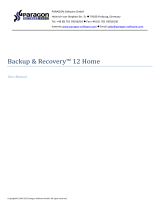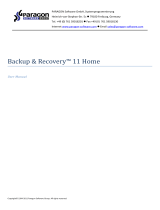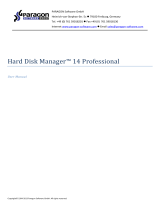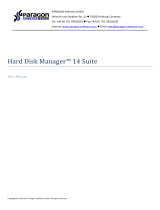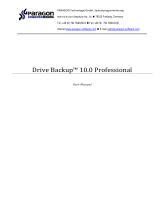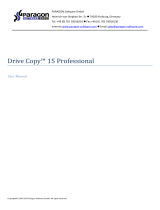Page is loading ...

PARAGON Software GmbH
Heinrich-von-Stephan-Str. 5c 79100 Freiburg, Germany
Tel. +49 (0) 761 59018201 Fax +49 (0) 761 59018130
Internet www.paragon-software.com Email sales@paragon-software.com
Copyright© 1994-2014 Paragon Software GmbH. All rights reserved.
Backup & Recovery™ 14 Home
User Manual

2
Copyright© 1994-2014 Paragon Software GmbH. All rights reserved.
Contents
Introduction .......................................................................................................................... 7
What’s New in Backup & Recovery 14 ......................................................................................................... 7
Product Components ............................................................................................................. 8
Features Overview ................................................................................................................. 9
Features ..................................................................................................................................................... 9
User Friendly Fault Minimizing Interface ................................................................................................................................ 9
Backup Facilities ...................................................................................................................................................................... 9
Restore Facilities ................................................................................................................................................................... 10
Copy Facilities ....................................................................................................................................................................... 11
Partition/Hard Disk Management Facilities .......................................................................................................................... 11
Automatization Facilities ...................................................................................................................................................... 11
Auxiliary Facilities ................................................................................................................................................................. 11
Supported Technologies ............................................................................................................................. 12
Supported File Systems .............................................................................................................................. 12
Supported Media ....................................................................................................................................... 13
Getting Started .................................................................................................................... 13
System Requirements ................................................................................................................................ 13
Installation ................................................................................................................................................ 14
First Start ................................................................................................................................................... 15
Building Recovery Media ............................................................................................................................ 16
Booting from the Linux/DOS Recovery Media ............................................................................................. 16
Startup .................................................................................................................................................................................. 16
Boot menu ............................................................................................................................................................................ 17
Booting from the WinPE Recovery Media ................................................................................................... 19
Startup .................................................................................................................................................................................. 19
Basic Concepts ..................................................................................................................... 21
System and Data Protection ....................................................................................................................... 21
File Backup versus Sector Backup ......................................................................................................................................... 21
Backup Types ........................................................................................................................................................................ 22
Backup Storage ..................................................................................................................................................................... 24
Adaptive Restore .................................................................................................................................................................. 25
Paragon Hot Processing & Volume Shadow Copy Service ............................................................................ 26
Offline versus Online Data Processing .................................................................................................................................. 26

3
Copyright© 1994-2014 Paragon Software GmbH. All rights reserved.
Paragon Hot Processing Technology .................................................................................................................................... 27
Volume Shadow Copy Service .............................................................................................................................................. 27
pVHD Support ............................................................................................................................................ 27
Dynamic Disks ............................................................................................................................................ 28
GPT versus MBR ......................................................................................................................................... 28
uEFI Boot Challenges .................................................................................................................................. 29
Apple Boot Camp ....................................................................................................................................... 29
64-bit Support ............................................................................................................................................ 29
Copy Operations ........................................................................................................................................ 30
Drive Partitioning ....................................................................................................................................... 30
Scheduling ................................................................................................................................................. 31
Windows BitLocker .................................................................................................................................... 31
Windows Components ........................................................................................................ 32
Interface Overview .................................................................................................................................... 32
General Layout ...................................................................................................................................................................... 32
Tool Button ........................................................................................................................................................................... 33
Ribbon Panel ......................................................................................................................................................................... 34
Virtual Operations Bar .......................................................................................................................................................... 34
Express Mode Button ........................................................................................................................................................... 34
Disk Map ............................................................................................................................................................................... 35
Disk and Partitions List .......................................................................................................................................................... 35
Context-sensitive Menu ........................................................................................................................................................ 36
Properties Panel .................................................................................................................................................................... 37
Status Bar .............................................................................................................................................................................. 38
Settings Overview ...................................................................................................................................... 38
General Options .................................................................................................................................................................... 38
Backup Image Options .......................................................................................................................................................... 39
General Copy and Backup Options ....................................................................................................................................... 40
CD/DVD/BD Recording Options ............................................................................................................................................ 41
Hot Processing Options ......................................................................................................................................................... 42
Run during Backup Options .................................................................................................................................................. 43
Partitioning Options .............................................................................................................................................................. 44
E-Mail Options ...................................................................................................................................................................... 45
Operation Dependency Options ........................................................................................................................................... 46
Virtual Mode Options ........................................................................................................................................................... 47

4
Copyright© 1994-2014 Paragon Software GmbH. All rights reserved.
File System Conversion Options ........................................................................................................................................... 47
Copy/Backup Exclude Options .............................................................................................................................................. 48
File Backup Exclude Options ................................................................................................................................................. 49
File Backup Include Options.................................................................................................................................................. 50
Log Files Options ................................................................................................................................................................... 51
FTP Sites Options .................................................................................................................................................................. 52
Viewing Disk Properties ............................................................................................................................. 53
Viewing Image Properties .......................................................................................................................... 53
Using the Restore Wizard ..................................................................................................................................................... 53
Using the Archive Database .................................................................................................................................................. 57
Data Backup and Rescue ............................................................................................................................ 58
Creating Backup Images ........................................................................................................................................................ 58
Restoring System and Data ................................................................................................................................................... 61
Copy Tasks ................................................................................................................................................. 66
Cloning Hard Disks ................................................................................................................................................................ 66
Cloning Partitions .................................................................................................................................................................. 69
Partition Management ............................................................................................................................... 70
Basic Partitioning Operations ............................................................................................................................................... 70
Advanced Partitioning Operations........................................................................................................................................ 74
Changing Partition Attributes ............................................................................................................................................... 76
Hard Disk Management ............................................................................................................................. 79
Converting Dynamic MBR to Basic ....................................................................................................................................... 79
Converting GPT to Basic MBR ............................................................................................................................................... 80
Converting Basic MBR to GPT ............................................................................................................................................... 81
Updating MBR ....................................................................................................................................................................... 81
Changing Primary Slot ........................................................................................................................................................... 82
Task Scheduling ......................................................................................................................................... 83
Setting a Timetable ............................................................................................................................................................... 83
Managing Tasks .................................................................................................................................................................... 84
Creating a Scheduled Task .................................................................................................................................................... 86
Scripting .................................................................................................................................................... 86
Extra Functionality ..................................................................................................................................... 88
View Partition/Hard Disk Properties ..................................................................................................................................... 88
Volume Explorer ................................................................................................................................................................... 89
File Transfer Wizard .............................................................................................................................................................. 91
Mount Partition .................................................................................................................................................................... 92

5
Copyright© 1994-2014 Paragon Software GmbH. All rights reserved.
Mount Archive ...................................................................................................................................................................... 93
Test Surface .......................................................................................................................................................................... 95
Check File System Integrity ................................................................................................................................................... 95
Check Archive Integrity ......................................................................................................................................................... 96
Check Recovery Discs ............................................................................................................................................................ 97
Edit/View Sectors .................................................................................................................................................................. 98
Send Log Files ........................................................................................................................................................................ 99
View Logs .............................................................................................................................................................................. 99
Typical Scenarios ............................................................................................................... 100
Backup Scenarios ..................................................................................................................................... 100
Creating the Backup Capsule .............................................................................................................................................. 100
Backing up a hard disk or partition to the Backup Capsule ................................................................................................ 102
Backing up a hard disk or partition to external media (CD/DVD) ....................................................................................... 104
Backing up a hard disk or partition to a network drive ...................................................................................................... 106
Backing up files to an FTP/SFTP server ............................................................................................................................... 111
Backing up a dual boot Mac to an external USB drive........................................................................................................ 113
Backing up files to a local mounted/unmounted (without drive letter assigned) partition .............................................. 116
Creating a differential to a full partition backup ................................................................................................................ 119
Creating a sector increment to pVHD ................................................................................................................................. 122
Creating a sector increment to a full partition backup ....................................................................................................... 125
Creating a file increment to a full partition backup ............................................................................................................ 128
Creating an increment to a full file backup ........................................................................................................................ 131
Creating a cyclic partition backup ....................................................................................................................................... 133
Merging a full partition backup with one of its differentials .............................................................................................. 136
Recovery Scenarios .................................................................................................................................. 138
Correcting EFI parameters .................................................................................................................................................. 138
Correcting BCD (Boot Configuration Data) ......................................................................................................................... 139
Fixing Windows startup ability ........................................................................................................................................... 140
Restoring a hard disk from the bootable Backup Capsule .................................................................................................. 143
Restoring a system partition from external media (CD/DVD) ............................................................................................ 146
Restoring a system partition from a network drive ............................................................................................................ 148
Restoring a system partition from a local drive .................................................................................................................. 155
Restoring a dual boot Mac from an external USB drive ..................................................................................................... 158
Restoring a file increment................................................................................................................................................... 160
Restoring a file increment to a partition backup ................................................................................................................ 163
Copying of data from the corrupted system disk to another hard disk ............................................................................. 165

6
Copyright© 1994-2014 Paragon Software GmbH. All rights reserved.
Burning of data from the corrupted system disk to CD/DVD ............................................................................................. 167
Copying of data from a backup to the corrupted system partition .................................................................................... 169
Restoring separate files and folders from a backup ........................................................................................................... 172
System Migration Scenarios ..................................................................................................................... 177
Migrating system to a new HDD (up to 2.2TB in size) ........................................................................................................ 177
Making system bootable on different hardware (P2P Adjust OS) ...................................................................................... 179
Extra Scenarios for WinPE ........................................................................................................................ 185
Adding specific drivers ........................................................................................................................................................ 186
Configuring network ........................................................................................................................................................... 187
Saving log files ..................................................................................................................................................................... 190
How to Work with Bitlocked Volumes ...................................................................................................... 191
In Windows ......................................................................................................................................................................... 191
In WinPE .............................................................................................................................................................................. 193
Troubleshooter .................................................................................................................. 195
Glossary ............................................................................................................................. 196

7
Copyright© 1994-2014 Paragon Software GmbH. All rights reserved.
Introduction
Paragon Backup & Recovery™ 14 Home is a complex disaster recovery solution. By including into this product the brand-
new disk imaging technology that allows backing up directly to virtual containers (pVHD, VHD, VMDK), complete support
of GPT/uEFI configurations, Windows BitLocker and the latest Windows 8.1, as well as the option to create an advanced
WinPE or Linux based recovery environment on CD/DVD, flash, or in an ISO-file, the company has offered all the
necessary facilities to build a bullet-proof shield against any disaster.
In this manual you will find the answers to many of the technical questions, which might arise while using the program.
Our company is constantly releasing new versions and updates to its software, that's why
images shown in this manual may be different from what you see on your screen.
What’s New in Backup & Recovery 14
Complete uEFI support. Below you can find only new features introduced in this version:
- A 64-bit Windows OS system configured to the uEFI boot mode can be adjusted to successfully start up on
another hard disk during copy/restore accomplished directly under Windows. Previously the uEFI fixup was
only available under WinPE;
- The Linux-based recovery environment supports systems configured to the uEFI boot mode.
Enhanced backup format. Paragon introduces a pVHD (Paragon Virtual Hard Drive) format – a special VHD,
optimized for storing backups of virtual and physical machines. It’s very efficient in handling incremental chains,
data de-duplication and synchronization. pVHD allows obtaining backups that are up to four times smaller than
original backup objects. What you get by using pVHD:
- Incremental imaging works much faster and rock-stable in comparison with the old PBF;
- Only pVHD images can be used to do immediate virtualization;
- With the new backup technology, Paragon has also achieved easy support of any virtual containers (VMDK,
VHD, etc.).
In the current version the pVHD support has a promotional goal. In future releases pVHD
will gradually take the primary role.
`
Support of Windows BitLocker to back up, restore or copy volumes encrypted by this security feature.
Copy/Restore to dissimilar sector size. Previously not allowed, now you can for instance copy or restore
contents of a 512-byte hard disk to a 4k hard disk with no additional actions from your side.
New UIM (Universal Image Mounter). Apart from PBF images, Universal Image Mounter enables to mount
(assign a drive letter to) pVHD backup images (full and incremental) to browse their contents and retrieve data
both, in the program and directly under Windows OS.
GPT/uEFI compatible Backup Capsule. Paragon's bootable backup capsule is compatible with 64-bit Windows
systems resided on GPT volumes. If having to do with this type of configuration, by selecting one additional
option in the Manage Backup Capsule Wizard, you can build a WinPE-based bootable backup capsule to
successfully start up PC from it in case of emergency. To accomplish this action, you will need to provide a path

8
Copyright© 1994-2014 Paragon Software GmbH. All rights reserved.
to an .ISO image of the WinPE recovery environment, which can be prepared either with Paragon's Recovery
Media Builder or Boot Media Builder.
Uplifted Recovery Media Builder. Paragon’s Recovery Media Builder, a simple alternative to Boot Media
Builder, can help you prepare either Linux or WinPE-based bootable environment on a USB thumb drive or in an
ISO file (previously only creation of WinPE images on USB was supported). Unlike Boot Media Builder, it doesn’t
require to have Windows Assessment and Deployment Kit (ADK) or Automated Installation Kit (WAIK) installed
in the system. However, it can only be used under Windows 7 or higher, and its functionality is rather limited.
Complete support of Windows Storage Spaces. Windows 8 has come with a storage management feature called
the storage spaces. It enables to easily manage large storage pools. In fact it's an expandable virtual container of
defined data size, allowing users to add it as many physical drives as they want until the defined virtual disk’s
limit is reached. This makes it easy to include additional storage devices without having to set up and manage
each attached physical storage drive.
Uplifted Linux Recovery Environment. Started from HDM 14 the Linux-based recovery environment is based on
SuSe 12.3 (more hardware devices supported) and includes:
- P2P Adjust OS Wizard to successfully migrate a Windows physical system to a different hardware platform
(P2P);
- uEFI fixup to clone, restore, migrate 64-bit Windows systems configured to the uEFI boot mode.
Separate x86 and x64 installation packages. Please note that started from HDM 14 installation packages do not
include Recovery Media Builder, thus customers can build Linux or WinPE-based recovery media only through
special utilities (Recovery Media Builder or Boot Media Builder) obtained from Paragon's website.
Windows 8.1 support. Our product has been tested to work fine on Windows 8.1 RTM.
New user-friendly interface that is fully compatible with the Windows 8 streamlined, tile-oriented interface:
- Metro-style Express Launcher;
- Ribbon-based full scale launcher.
GUI of the Linux recovery environment has also been uplifted.
Product Components
In order to cope with different tasks, the product contains several components:
Windows based set of utilities is the crucial part of the product. With the help of an easy to use launcher you
may find and run tasks of any complexity in the field of data and system protection, hard disk partitioning and
cloning, etc.
Linux/DOS based recovery environment is a multi-platform bootable media that enables to run utilities under
Linux or PTS DOS, and that way to get access to your hard disk for maintenance or recovery purposes. Both
platforms have their strong sides, for instance Linux can boast support of FireWire (i.e. IEEE1394) or USB
devices. It enables to burn CD/DVD discs. However there can be some difficulties with detecting new hardware.
DOS in its turn has no problems of that kind but is limited in features. The Linux/DOS recovery environment
requires no installation and can be of great help when the system fails to boot. Besides it offers a Windows XP
like environment.
WinPE based recovery environment. Especially for keen followers of Windows, our product offers the option to
prepare a WinPE based bootable media. Unlike the Linux/DOS recovery environment it can boast an excellent

9
Copyright© 1994-2014 Paragon Software GmbH. All rights reserved.
hardware support and the same interface as the Windows version can. However its system requirements are
much tougher.
Features Overview
This chapter dwells upon key benefits and technical highlights of the product.
Features
Let us list some of the features:
User Friendly Fault Minimizing Interface
Graphical representation of the data to gain a better understanding.
A handy Launcher to easily find and run the required tasks.
Comprehensive wizards to simplify even the most complex operations.
A context sensitive hint system for all functions of the program.
Previewing the resulting layout of hard disks before actually executing operations (so-called virtual
operations).
Backup Facilities
Archive Database to help the user easily manage backup images (get properties, add, delete, mount, etc.).
This feature is only available for the Windows installation of the program.
Available location for backup images:
- Backup to local mounted partitions.
- Backup to local unmounted (without drive letter assigned) partitions.
- Backup to an external mounted storage to provide for a higher level of data protection and system
independence.
- Backup to a special secured place on the hard disk called the Backup Capsule that has an independent system
layout (e.g. a separate partition) and will stay operable should the active file system be damaged. To avoid an
accidental removing or unauthorized access of the backup data, this partition is hidden and thus cannot be
mounted in the operating system.
- Backup to external media (CD/DVD) to guarantee a high level of data protection as long as the backup media is
kept secure.
- Backup to a network drive to stand a better chance of success in case of a hard disk failure.
- Backup to an FTP/SFTP server to provide a new level of system and data protection.
Bootable Backup Capsule to get the choice to launch the Linux or PTS DOS recovery environment every time
you start up the computer. With its help you will be able to run utilities under Linux or PTS DOS, and that way to
get access to your hard disk for maintenance or recovery purposes.
For PBF images:

10
Copyright© 1994-2014 Paragon Software GmbH. All rights reserved.
Smart Backup Wizard to secure system and data with the minimal efforts possible. With a unique intelligent
work algorithm and a highly intuitive user interface, you can easily back up exactly what you need - the whole
system, e-mail databases (MS Outlook, Express, Windows Mail) media files or office documents of the My
Documents folder, or any other files and folders.
Differential backup to a sector image to only archive changes since the last full sector-based image, thus
considerably saving the backup storage space. To restore this kind of backup you will require a full image and
one of its differentials.
Incremental backup to a sector image is a further way of optimizing the process of disk imaging. Unlike
differentials, it may not only contain data changed since the time of creating a full sector-based archive, but one
of its increments as well, thus allowing to save more time and the backup storage. Introduction of a special
index file that stores backup meta-information minimizes time and resources to create this type of archives.
Incremental backup to a file image to only archive changes since the last full or incremental file-based image.
An incremental image is smaller and takes less time to create, but you will require the initial full image and all of
its increments to restore the latest point of this kind of backup.
File backup to a sector image. It is a unique technology on the market so far that bridges two principally
different approaches of the data backup: the file-based backup and the disk imaging backup. With its help you
can now create a sector-based backup of your system to get it back on track in minutes in case of a virus attack
or a hardware malfunction and then just make file-based incremental images to the previously created sector-
based backup to keep updated only information that is critical for you. Thus you will considerably save your
system resources.
Cyclic backup to automate the backup of separate partitions. It is an ideal option if you want to establish a self-
acting data protection system.
This feature is only available for the Windows installation of the program.
Synthetic backup to change any property (merge a given differential image with its full image, split/un-split,
compress/de-compress, etc.) of an existing backup image without carrying out a physical backup operation.
For pVHD images:
Backup to VD Wizard to protect separate partitions or entire hard disks.
Incremental Backup to VD Wizard to create incremental backup chains based on the base pVHD image.
Restore Facilities
Restore an entire disk, separate partitions or only files you need from the previously created backup image (for
PBF and pVHD).
Restore with Shrink to restore a backup image to a free block of smaller size taking into account only the
amount of actual data of the image.
Adaptive Restore to successfully migrate a Windows physical system to a different hardware platform (P2P) by
allowing automatic injection of all required drivers and the other actions crucial for a migration of this kind.

11
Copyright© 1994-2014 Paragon Software GmbH. All rights reserved.
This feature is only available for the bootable recovery environment.
Copy Facilities
Partition/hard disk copy to successfully transfer all on-disk information including standard bootstrap code and
other system service structures, thus maintaining the operating system’s working capability.
Copy functionality can also be used as an alternative way of data protection.
Partition/Hard Disk Management Facilities
Basic functions for initializing, partitioning and formatting hard disks (create, format, delete). Instead of the
standard Windows disk tools, the program supports all popular file systems.
Mount a partition (assign a drive letter) of any file system type to make it available for your operating system.
Modify file system parameters (make active/inactive, hide/unhide, etc.).
Undelete Partitions Wizard to recover an accidentally deleted partition.
Automatization Facilities
Task scheduling to automate routine operations. It can be particularly effective when you have to repeat a
sequence of actions on a regular basis.
Scheduling is only available for the Windows installation of the program.
Scripting to make the program create a script of any set of operations you need. Besides support of all
operations available in the interactive mode, the unattended mode provides some additional features, such as
conditional execution, subroutines, repeatable iterations, disk/partition properties analysis, errors
management, etc.
Auxiliary Facilities
Conversion of basic MBR disks to basic GPT to enjoy all benefits of the newest partitioning scheme with
minimal effort.
File Transfer Wizard to make such operations as transferring of files/directories or burning of them to CD/DVD
as easy and convenient as possible. Providing access to Paragon backups as regular folders, it may also help to
replace corrupted data from a previously created image in case of an operating system failure.
Volume Explorer is a handy tool when you have different file systems on the disk, whether they contain an
operating system or just data. Volume Explorer will let you explore a file system of any type and provide access
to the necessary files and directories regardless of their security attributes.
Network Configuration Wizard to establish a network connection on a bootable recovery media either to save a
backup of a partition/hard disk or just several files on a network computer or retrieve a previously made backup
from a network computer for recovery purposes.

12
Copyright© 1994-2014 Paragon Software GmbH. All rights reserved.
Boot Corrector to fix most of the system boot problems that can be a result of a human factor, program error or
a boot virus activity.
Boot Corrector is only available for the bootable recovery environment.
Supported Technologies
Along with using innovative technologies from outside, Paragon has developed a number of its own original
technologies that make its products unique and attractive for customers:
Paragon Hot Backup™ technology to back up locked partitions and hard disks under Windows NT+ family
operating systems providing both high operating efficiency as well as low hardware requirements.
Paragon Hot Copy™ technology to copy locked partitions and hard disks under Windows NT+ family operating
systems providing both high operating efficiency as well as low hardware requirements.
Paragon Adaptive Restore™ technology to successfully migrate a Windows physical system to a different
hardware platform (P2P).
Paragon Power Shield™ technology to provide data consistency in case of a hardware malfunction, power
outages or an operating system failure.
Paragon UFSD™ technology to browse partitions of any file system including hidden and unmounted, modify
and copy files and folders, etc.
Paragon Restore with Shrink™ technology to restore a backup image to a free block of smaller size taking into
account only the amount of actual data of the image.
Paragon BTE™ technology to set tasks for execution during the system restart, thus saving from the need to use
a bootable media when modifying system partitions.
Microsoft Volume Shadow Copy Service (VSS) to provide the copy/backup infrastructure for the Microsoft
Windows XP/Vista/7/Server 2003/2008 operating systems. It offers a reliable mechanism to create consistent
point-in-time copies of data known as shadow copies. Developed by Microsoft in close cooperation with the
leading copy/backup solution vendors on the market, it is based on a snapshot technology concept.
Microsoft Dynamic Disk (simple, spanned, striped, mirrored, RAID-5) to offer more management flexibility
without the partition limitation of basic disks. Dynamic storage can be particularly beneficial for large-scale
businesses when dealing with many physical hard disks involving complex setup.
GUID Partition Table (GPT). It is the next generation of a hard disk partitioning scheme developed to lift
restrictions of the old MBR. GPT disks are now supported by Windows Vista/7, Server 2008, Mac OS X and Linux.
Supported File Systems
Full read/write access to FAT16/FAT32 partitions.
Full read/write access to NTFS (Basic Disks) under Windows, Linux and PTS DOS. Compressed NTFS files are also
supported.
Full read/write access to Ext2FS/Ext3FS/Ext4FS partitions.
Limited read/write access to Apple HFS+ partitions.

13
Copyright© 1994-2014 Paragon Software GmbH. All rights reserved.
Unfortunately, support of non-Roman characters for the HFS+ file system is unavailable at
the moment. The company is about to implement it in the nearest future.
Supported Media
Support of both MBR and GPT hard disks (2.2TB+ disks included)
IDE, SCSI and SATA hard disks
SSD (Solid State Drive)
AFD (Advanced Format Drive)
Non-512B sector size drives
CD-R, CD-RW, DVD-R, DVD+R, DVD-RW, DVD+RW, DVD-R, DVD+R double layer and also Blu-ray discs
FireWire (i.e. IEEE1394), USB 1.0, USB 2.0, USB 3.0 hard disks
PC card storage devices (MBR and GPT flash memory, etc.)
Getting Started
In this chapter you will find all the information necessary to get the product ready to use.
System Requirements
For the Windows installation package
Windows XP SP3
Windows Vista
Windows 7
Windows 8
Windows 8.1
Additional requirements:
To install and run the product the target OS should have Visual Studio C++ 2010 Runtime Library installed
(comes with the installation package – you will be prompted to install it, if it’s not been found in the system).
During the installation additional free space (up to 1GB) will be required.
For the Linux bootable environment
Intel Pentium CPU or its equivalent, with 300 MHz processor clock speed
256 MB of RAM
SVGA video adapter and monitor
Keyboard
Mouse

14
Copyright© 1994-2014 Paragon Software GmbH. All rights reserved.
For the WinPE bootable environment
Intel Pentium III CPU or its equivalent, with 1000 MHz processor clock speed
At least 1 GB of RAM
SVGA video adapter and monitor
Keyboard
Mouse
Additional requirements
Network card to send/retrieve data to/from a network computer
Recordable CD/DVD drive to burn data to compact discs
External USB hard drive to store data.
Installation
Before the installation, please make sure the systems requirements are met. If everything is OK, please do the following
to install the product:
In case there is some previous version of the program installed on the computer, the
program will offer the user to uninstall it first.
1. Click on the supplied setup file to initiate the installation. First your system will be checked for the presence of
Visual Studio C++ 2010 Runtime Library and if not found, you will be prompted to install it (comes with the
installation package). Click Install to continue.
2. The Welcome page will inform that the application is being installed. Click Next to continue.
3. Please Read Paragon License Agreement carefully and then select the appropriate option to accept. Otherwise
you won’t be able to proceed with the installation. By clicking the Print button, the license agreement may also
be printed out.
4. Provide your product key and serial number.
5. On the Customer Information page you are to provide the standard customer information, i.e. a user name and
an organization. Besides you need to decide whether to make the program available for all users of this
computer (if several) or only for the current one.

15
Copyright© 1994-2014 Paragon Software GmbH. All rights reserved.
6. On the next page, click Change to install the utility to a different location (by default C:\Program Files\Paragon
Software\Paragon Backup & Recovery 14 Home Edition\). Otherwise click Next to continue.
Do not install the program on network drives. Do not use Terminal Server sessions to install
and run the program. In both cases, the program functionality will be limited.
7. On the Ready to Install the Program page click Install to start the installation or Back to return to any of the
previous pages and modify the installation settings.
8. The Final page reports the end of the setup process. Click Finish to complete the wizard.
First Start
To start Paragon Backup & Recovery 14 under Windows, please click the Windows Start button and then select
Programs > Paragon Backup & Recovery™ 14 > Paragon Backup & Recovery™.
The program provides wide opportunities in the field of hard disk structure modification, so
just to be on the safe side, please make a backup of your data before carrying out any
operation.
The first component that will be displayed is called the Express Launcher. Thanks to a well thought-out categorization
and hint system, it provides quick and easy access to wizards and utilities that we consider worth using on a regular
basis. With its help you can also start up the traditional launcher, the help system or go to the program’s home page.

16
Copyright© 1994-2014 Paragon Software GmbH. All rights reserved.
To know more on how to handle the product’s interface and accomplish typical operations,
please consult the Windows Components chapter.
Building Recovery Media
WinPE- and/or Linux-based recovery environments should be prepared on-site with Paragon’s Recovery Media Builder
or Boot Media Builder, which you can download from Paragon’s web site, the My Account section (www.paragon-
software.com/my-account/).To know more on the subject, please consult documentation that comes with these
utilities.
Booting from the Linux/DOS Recovery Media
The Linux/DOS recovery environment can be used to boot your computer into Linux or PTS DOS to get access to your
hard disk for maintenance or recovery purposes. It also has the PTS DOS safe mode, which may help in a number of non-
standard situations such as interfering hardware settings or serious problems on the hardware level. In this case, only
basic files and drivers (such as hard disk drivers, a monitor driver, and a keyboard driver) will be loaded.
Startup
To start working with the Linux/DOS recovery environment, please take the following steps:
1. Start up the computer from our Linux/DOS recovery media.

17
Copyright© 1994-2014 Paragon Software GmbH. All rights reserved.
Please use Recovery Media Builder or Boot Media Builder to prepare Paragon's recovery
environments on CD/DVD, flash, or in an ISO-image. You can get these utilities here:
www.paragon-software.com/my-account/.
To automatically boot from the recovery media please make sure the on-board BIOS is set
up to boot from CD/USB first.
2. Launch a boot mode you need (Normal, Safe, Low-Graphics Safe) in the Boot menu.
By default the Normal Mode will be automatically initiated after a 10 second idle period.
3. Click on the required operation to start. Hints on the selected at the moment item will help you make the right
choice.
4. Consult the help system by pressing ALT+F1 to know more on the subject.
Boot menu
32-bit environment
Normal Mode. Boot into the Linux normal mode. This mode uses the full set of drivers (recommended);
Safe Mode. Boot into the PTS DOS mode. This mode can be used as an alternative of the Linux normal mode if it
fails to work properly;
Low-Graphics Safe Mode. Boot into the PTS DOS safe mode. In this case, only the minimal set of drivers will be
included, like hard disk, monitor, and keyboard drivers. This mode has simple graphics and a simple menu;
Floppy Disk. Reboot the computer from a system floppy disk;
Hard Disk 0. Boot from the primary hard disk;
Find OS(s) on your hard disks. The program will scan hard disks of your computer to find any bootable operating
system.

18
Copyright© 1994-2014 Paragon Software GmbH. All rights reserved.
64-bit environment
Normal Mode. Boot into the Linux normal mode. This mode uses the full set of drivers (recommended);
Safe Mode. Boot into the PTS DOS mode. This mode can be used as an alternative of the Linux normal mode if it
fails to work properly;
Reboot. Restart the computer.
Power off. Shut down the computer.
While working with the recovery environment you might experience some inconvenience
caused by possible video artifacts. It is just a result of changing video modes and in no way
will affect the program functionality. If this is the case, please wait a bit and everything will
be OK.
Normal Mode
When the Normal mode is selected, the Linux launch menu appears:
Backup & Recovery (enables to run wizards and dialogs, to specify program settings, to visualize the operating
environment and the hard disk configuration);

19
Copyright© 1994-2014 Paragon Software GmbH. All rights reserved.
Backup Wizard (enables to back up hard disk and partitions);
Simple Restore Wizard (allows restoring hard disks and partitions);
File Transfer Wizard (allows coping files/folders to another disk or a partition as well as recording them to
CD/DVD);
Boot Corrector (helps to correct the Windows System Registry without Windows being loaded);
Network Configurator (enables to establish a network connection under Linux);
If you are going to use network resources, first launch the Network Configuration Wizard to
establish a network connection.
Log Saver (helps to collect and send the necessary log files to the Technical Support);
Eject CD/DVD;
Command Line (allows experienced users to execute any operation);
Reboot the computer;
Power off the computer.
To move within the menu, please use the arrow keys of the computer keyboard.
Safe Mode
When the Safe mode is selected, the PTS DOS launch menu appears. It has nearly the same functionality as for the
Normal mode except for the Network Configurator and Log Saver commands. Besides due to certain limitations of the
PTS DOS environment, there is no possibility to burn CD/DVD discs.
Low Graphics Safe Mode
When the Low Graphics mode is selected, the PTS DOS launch menu appears. It has the same functionality and looks
similar to the Safe mode but graphically simpler.
Booting from the WinPE Recovery Media
The WinPE recovery environment can be a real alternative to the Linux/DOS recovery environment. Providing nearly the
same level of functionality it offers an excellent hardware support and the same interface as the Windows version does.
Startup
To start working with the WinPE recovery environment, please take the following steps:
1. Start up the computer from the WinPE recovery media.

20
Copyright© 1994-2014 Paragon Software GmbH. All rights reserved.
Please use Boot Media Builder to prepare the WinPE recovery environment, which you can
get here: www.paragon-software.com/my-account/.
To automatically boot from the recovery media please make sure the on-board BIOS is set
up to boot from CD/USB first.
2. Once it has been loaded, you will see the Universal Application Launcher. In general it enables to run
components of the product, load drivers for undefined hardware or establish a network connection.
3. Click on the required operation to start. Hints on the selected at the moment item will help you make the right
choice.
4. Consult the help system by pressing ALT+F1 to know more on the subject.
The WinPE based recovery environment offers excellent hardware support. However in
case it doesn’t have a driver for your disk controller, your hard disks will be unavailable.
Please consult the Adding specific drivers scenario to know how to tackle this issue.
/
